The Economics and Statistics Division maintains archives of previous publications for accountability purposes, but makes no updates to keep these documents current with the latest data revisions from Statistics Canada. As a result, information in older documents may not be accurate. Please exercise caution when referring to older documents. For the latest information and historical data, please contact the individual listed to the right.
<--- Return to Archive
For additional information relating to this article, please contact:
February 01, 2022JAPAN LABOUR FORCE SURVEY, DECEMBER AND ANNUAL 2021 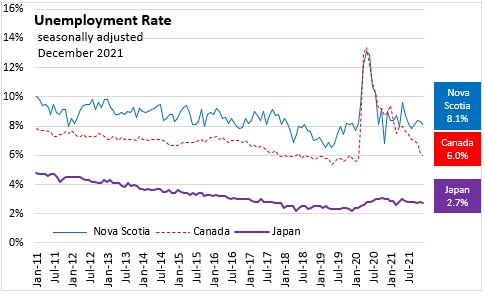
In December 2021, Japan's seasonally adjusted unemployment rate declined slightly to 2.7%. Employment was up 0.7% while the labour force grew by 0.6% compared to November 2021.
The impacts of COVID-19 are still apparent in Japan's labour market, where unemployment rates remain slightly higher than in the 2 years prior to the pandemic. Both employment and labour force remain below pre-pandemic levels. However, the magnitude of Japan's labour market shock from COVID-19 appears to be more moderate than observed in other advanced economies.
Compared to February 2020, Japan's labour force in December 2021 was down 0.8% while employment was down 1.0%. From February 2020 to December 2021, Canada's labour force was up by 1.5% while employment was up 1.2%. Canada's unemployment rate increased from 5.7% in February 2020 to 6.0% in December 2021. Nova Scotia's December 2021 labour force was up 0.1% and employment up 0.3% compared to February 2020. Nova Scotia’s unemployment rate was 8.2% in February 2020 and 8.1% in December 2021.
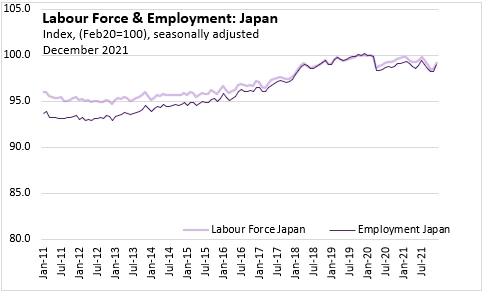
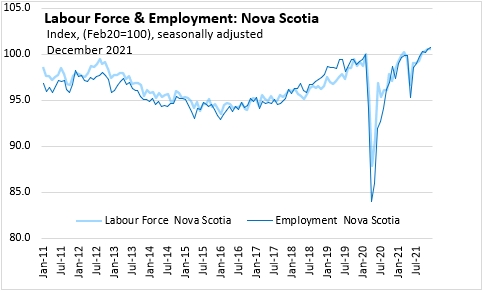

Annual Average 2021
Japan's unemployment rate has averaged 2.8% in each of 2020 and 2021, up from 2.4% in 2019 (and 2018) . Canada's unemployment rate increased from 5.7% in 2019 to 9.5% in 2020 before falling back to 7.5% in 2021. Nova Scotia's unemployment rate averaged 7.4% in 2019, which increased to 9.8% in 2020 and subsequently declined to 8.4% on average in 2021.

Japan's labour force declined slightly in 2021 (-0.1% vs 2020) and remained 0.4% below the 2019 value. Employment was down by 0.1% from 2020 to 2021 and remained 0.8% below the 2019 value.
Labour force and employment contracted more dramatically in 2020 in Canada and Nova Scotia, when compared with the modest reductions in Japan. However, labour force grew by 2.5% in Canada in 2021 while employment grew by 4.8%, when compared to 2020. Nova Scotia's labour force grew by 3.8% in 2021 while employment increased by 5.4%.
National labour force was 1.6% above its 2019 level in 2021 while employment was 1.2% higher. Nova Scotia's labour force was 1.6% higher in 2021 than in 2019 while employment was up by 0.5%.
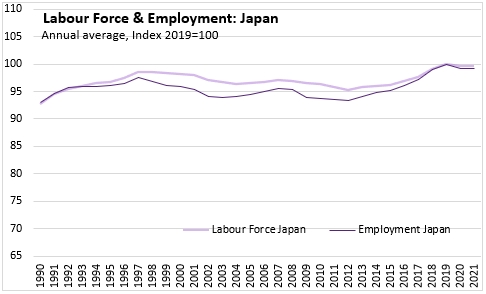
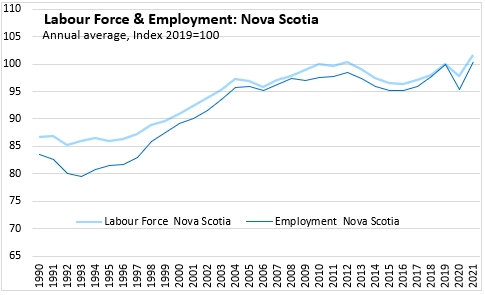
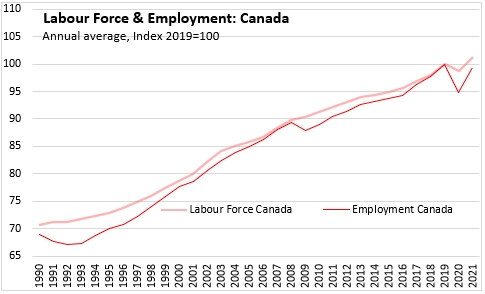
Sources:
Statistics Bureau of Japan. Table: a-1 (Seasonally adjusted) Major items (Labour force, Employed person, Employee, Unemployed person, Not in labour force, Unemployment rate (since Jan.1953); Population aged 15 years old and over by labour force status (annual average figures - Results of whole Japan)
Statistics Canada. Table 14-10-0287-01 Labour force characteristics, monthly, seasonally adjusted and trend-cycle; Table 14-10-0327-01 Labour force characteristics by sex and detailed age group, annual
<--- Return to Archive